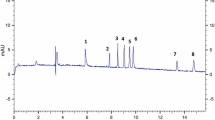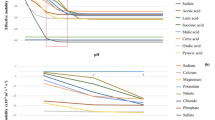Abstract
A capillary electrophoresis (CE) method has been developed and validated for determination of organic acids (oxalate, tartrate, malate, malonate, pyruvate, succinate, acetate, citrate, and lactate) and inorganic anions (sulfate and phosphate) in red wines. The separations were carried out in an automated separation system equipped with wide-bore (300 μm i.d.) fluoroplastic capillary and contact conductivity detector used for monitoring the separation and quantification of the analytes. The fast method (analysis time less than 5 min.) provided a good linearity of calibration curves (R 2 > 0.9920) for the studied acids, as well as a good reproducibility of migration times (RSD < 1.5%). In total, 17 red wines were analyzed with the proposed method, including Vranec, Cabernet Sauvignon, and Merlot wines from various geographic areas (Demir Kapija, Kavadarci, Negotino, and Veles) in Macedonia. The used fully automated separation system (sample dilution not included) predetermined the developed CE method for routine analysis.



Similar content being viewed by others
References
Castiñeira A, Peña RM, Herrero C, García-Martín S (2000) Simultaneous determination of organic acids in wine samples by capillary electrophoresis and UV detection: optimization with five different background electrolytes. J High Resol Chromatogr 23(11):647–652. https://doi.org/10.1002/1521-4168(20001101)23:11<647::AID-JHRC647>3.0.CO;2-Z
Castiñeira A, Peña RM, Herrero C, García-Martín S (2002) Analysis of organic acids in wine by capillary electrophoresis with direct UV detection. J Food Compos Anal 15(3):319–331. https://doi.org/10.1006/jfca.2002.1056
Davis CR, Wibowo D, Fleet GH, Lee TH (1988) Properties of wine lactic acid bacteria: their potential oenological significance. Am J Enol Vitic 39:137–142
Escobal A, Gonzalez J, Iriondo C, Laborra C (1997) Liquid chromatographic determination of organic acids in txakoli from Bikaia. Food Chem 58(4):381–384. https://doi.org/10.1016/S0308-8146(96)00032-5
Esteves VI, Lima SSF, Lima DLD, Duarte AC (2004) Using capillary electrophoresis for the determination of organic acids in Port wine. Anal Chim Acta 513(1):163–167. https://doi.org/10.1016/j.aca.2003.12.036
Falque-Lopez E, Fernández-Gómez E (1996) Simultaneous determination of the major organic acids, sugars, glycerol, and ethanol by HPLC in grape musts and white wines. J Chromatogr Sci 35(5):254–257. https://doi.org/10.1093/chromsci/34.5.254
Gomez FJV, Silva MF (2016) Microchip electrophoresis for wine analysis. Anal Bioanal Chem 408(30):8643–8653. https://doi.org/10.1007/s00216-016-9841-0
Ivanova-Petropulos V, Mitrev S (2014) Determination of SO2 and reducing sugars in Macedonian wines. Yearb Fac Agric 12:7–18 ISSN 1409-987X
Kubáň P, Hauser PC (2005) Application of an external contactless conductivity detector for the analysis of beverages by microchip capillary electrophoresis. Electrophoresis 26(16):3169–3178. https://doi.org/10.1002/elps.200500178
Liu Q, Wang L, Hu J, Miao Y, Wu Z, Li J (2017) Main organic acids in rice wine and beer determined by capillary electrophoresis with indirect UV detection using 2, 4-dihydroxybenzoic acid as chromophore. Food Anal Methods 10:111–117. https://doi.org/10.1007/s12161-016-0559-6
Masár M, Kaniansky D, Bodor R, Jöhnck M, Stanislawski B (2001) Determination of organic acids and inorganic anions in wine by isotachophoresis on a planar chip. J Chromatogr A 916(1-2):167–174. https://doi.org/10.1016/S0021-9673(00)01094-3
Masár M, Poliaková K, Danková M, Kaniansky D, Stanislawski B (2005) Determination of organic acids in wine by zone electrophoresis on a chip with conductivity detection. J Sep Sci 28(9-10):905–914. https://doi.org/10.1002/jssc.200500061
Mato I, Suárez-Luque S, Huidobro JF (2007) Simple determination of main organic acids in grape juice and wine by using capillary zone electrophoresis with direct UV detection. Food Chem 102(1):104–112. https://doi.org/10.1016/j.foodchem.2006.05.002
OIV (International organization of vine and wine) (2016) Compendium of international methods of analysis of wines and musts. Paris, France, Vol. 1. Available from: http://www.oiv.int/public/medias/4231/compendium-2016-en-vol1.pdf
Peres RG, Moraes EP, Micke GA, Tonin FG, Tavares MFM, Rodriguez-Amaya DB (2009) Rapid method for the determination of organic acids in wine by capillary electrophoresis with indirect UV detection. Food Control 20(6):548–552. https://doi.org/10.1016/j.foodcont.2008.08.004
Regmi U, Palma M, Barroso CG (2012) Direct determination of organic acids in wine and wine-derived products by Fourier transform infrared (FT-IR) spectroscopy and chemometric techiques. Anal Chim Acta 732:137–144. https://doi.org/10.1016/j.aca.2011.11.009
Saavedra L, Barbas C (2003) Validated capillary electrophoresis method for samall-anions measurement in wines. Electrophoresis 24(1213):2235–2243. https://doi.org/10.1002/elps.200305415
Schneider A, Gerbi V, Redoglia M (1987) A rapid HPLC method for separation and determination of major organic acids in grape musts and wines. Am J Enol Vitic 38:151–155
Tašev K, Stefova M, Ivanova-Petropulos V (2016) HPLC method validation and application for organic acid analysis in wine after solid-phase extraction. Maced J Chem Chem Eng 35(2):225–233. https://doi.org/10.20450/mjcce.2016.1073
Tusseau D, Benoit C (1987) Routine high-performance liquid chromatographic determination of carboxylic acids in wines and champagne. J Chromatogr 395:323–333. https://doi.org/10.1016/S0021-9673(01)94121-4
Verheggen ThPEM, Beckers JL, Everaerts FM (1988) Simple sampling device for capillary isotachophoresis and capillary zone electrophoresis. J Chromatogr A 452:615–622. 10.1016/S0021-9673(01)81484-9
Xiong Z, Dong Y, Zhou H, Wang H, Zhao Y (2014) Simultaneous determination of 16 organic acids in food by online enrichment ion chromatography−mass spectrometry. Food Anal Methods 7:1908–1916. https://doi.org/10.1007/s12161-014-9839-1
Yan Z, Xingde Z, Weiju N (1997) Simultaneous determination of carbohydrates and organic acids in beer and wine by ion chromatography. Mikrochim Acta 127(3-4):189–194. https://doi.org/10.1007/BF0124272
Zotou A, Lokou Z, Karava O (2004) Method development for the determination of seven organic acids in wines by reversed-phase high performance liquid chromatography. Chromatographia 60(1-2):39–44. https://doi.org/10.1365/s10337-004-0330-9
Acknowledgements
This work was financially supported by following projects: “Biogenic aminies and aroma in Vranec wines from Macedonia and Montenegro and effect of malolactic fermentation on their formation,” provided by the Macedonian Ministry of Education and Science and “Chemical characterization of wine, alcoholic beverages and food by instrumental techniques” provided by University “Goce Delčev”—Štip. The financial support of the Slovak Research and Development Agency (APVV-0259-12) and the Scientific Grant Agency of the Ministry of Education, Science, Research, and Sport of the Slovak Republic and the Slovak Academy of Sciences (VEGA 1/0342/15) is gratefully acknowledged. One of us (Z.L.) thanks SAIA and CEEPUS (CIII-RO-0010-11-1617) mobility grants.
Funding
Macedonian Ministry of Education and Science of the Republic of Macedonia; University “Goce Delčev”—Štip; the Slovak Research and Development Agency; the Scientific Grant Agency of the Ministry of Education, Science, Research, and Sport of the Slovak Republic and the Slovak Academy of Sciences; and Slovak Academic Information Agency.
Author information
Authors and Affiliations
Corresponding author
Ethics declarations
Conflict of Interest
Zorica Lelova declares that she has no conflict of interest. Violeta Ivanova-Petropulos declares that she has no conflict of interest. Marián Masár declares that he has no conflict of interest. Klemen Lisjak declares that he has no conflict of interest. Róbert Bodor declares that he has no conflict of interest.
Ethical Approval
This article does not contain any studies with animals.
Informed Consent
It was obtained from all individual participants included in the study.
Rights and permissions
About this article
Cite this article
Lelova, Z., Ivanova-Petropulos, V., Masár, M. et al. Optimization and Validation of a New Capillary Electrophoresis Method with Conductivity Detection for Determination of Small Anions in Red Wines. Food Anal. Methods 11, 1457–1466 (2018). https://doi.org/10.1007/s12161-017-1117-6
Received:
Accepted:
Published:
Issue Date:
DOI: https://doi.org/10.1007/s12161-017-1117-6




